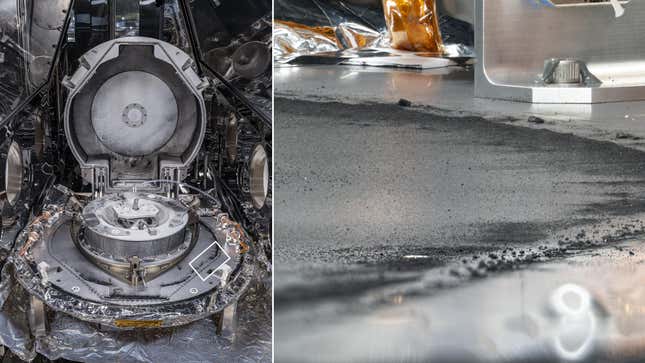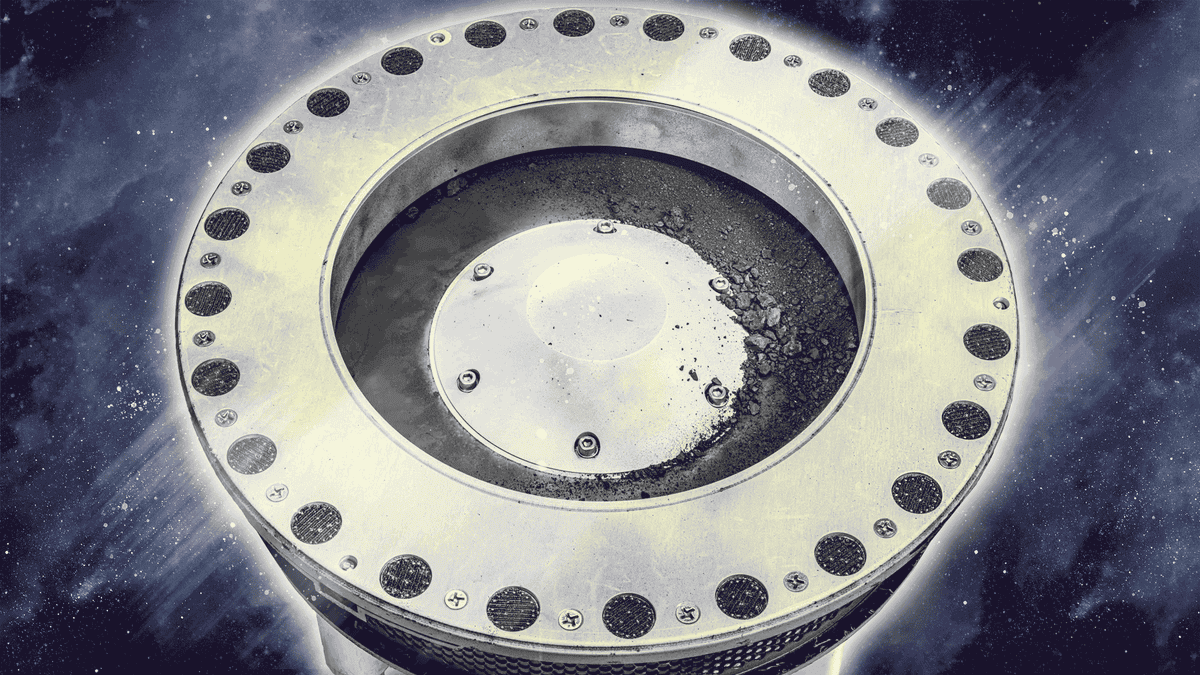We’ve all been there: You’re getting some peanut butter, or looking to nosh a nice pickle, when you find your wrist strength is insufficient to get at the jar’s delicious contents. That’s more or less NASA’s vexing issue with the OSIRIS-REx asteroid samples—though, of course, that canister’s contents aren’t for eating.
That’s right. NASA was able to launch a $1.16 billion mission to an asteroid 200 million miles from Earth, retrieve crumbly bits of space rock, and bring them all the way back to our humble habitable world. And now it can’t open the jar. Specifically, two fasteners on TAGSAM (Touch-and-Go Sample Acquisition Mechanism) are refusing to yield to the currently available tools. Scientists hope the samples asteroid Bennu could hold clues to the formation of the solar system and the origins of life, so they’re understandably eager to get things moving.
Luckily, the outside of the sample canister itself was covered in an abundance of asteroid material, meaning some science has already begun. In a press conference last month, OSIRIS-REx sample analyst Daniel Glavin described the asteroid bits as “an astrobiologist’s dream.” They’ve already identified carbon and water molecules.
Gizmodo reached out to several astrobiologists to discuss what exactly they hope to learn from a full analysis of the ancient asteroid material. Here’s what they had to say.
“The OSIRIS-REx samples could help us to find out, if besides the supposed delivery of water on the primordial Earth by comets, this could also be realized by asteroids,” said Jean-Pierre de Vera, an astrobiologist at the German Aerospace Center and President of the European Astrobiology Network Association (EANA), in an email to Gizmodo. “The question still remains on the amount of organics in these rocks which could be delivered on Earth and might have served as the first building blocks of life.”
Whenever meteorites are found on Earth, they offer scientists an opportunity to investigate the origins of the solar system. Many of these rocky bits are carbonaceous chondrites, a class of ancient carbon-bearing meteorites that contain building blocks for life and show signs of aqueous alteration—changes to their structure due to liquid water. As such, they offer an intimate window into how our solar system formed and gave rise to a world like Earth—rich with plate tectonics, covered in oceans, and crowded with living things.
But meteorites that land on Earth are immediately contaminated by, well, Earth. Thanks to the OSIRIS-REx team’s painstaking effort, scientists finally have access to asteroid samples untainted by the vast amount of organic material and alteration that comes with burning up in our planet’s atmosphere and hitting the surface, be it land or sea.
“For the first time we will be able to measure the abundances of all 20 protein-forming amino acids from an asteroid sample untouched by life on Earth,” said Sawsan Wehbi, an astrobiologist at the University of Arizona, in an email to Gizmodo. “My goal is to compare the amino acids we find on Bennu to Earth’s early life. I’m hoping to answer this question: Did early life use the building blocks that were delivered from outer space?”

Whether the samples suggest that ingredients for life processes came from space or may have come from Earth itself, Wehbi said that “I think what we find will fundamentally change our perspective on how we think about life in a cosmological context.”
Bennu is named for an Ancient Egyptian deity associated with rebirth that is the living symbol of the god Osiris, who was himself brought back to life in Egyptian myth. It is a primitive asteroid, dating to the first 10-million-or-so years of the solar system’s existence. As such, scientists believe the asteroid could hold secrets of what the earliest stages of solar system formation could look like, as well as what primordial organic components—to lean on an old cliché, the “building blocks for life”—might exist on the rocky body.
But it’s not quite as simple as that. Bennu underwent some changes in its early existence, which means that scientists will be able to see more than just “building blocks”—they’ll be able to see the game plan an evolving Bennu was following.
“This is sort of a fossil snapshot of some of the most primitive material in the solar system,” said Michael Wong, an astrobiologist at Carnegie Science, in a phone call with Gizmodo. “But a little bit of time elapsed between its formation and where it essentially froze out and stopped evolving as a planetary body.”
“Trying to understand how much chemical complexification has occurred in that brief snapshot of time between when Bennu formed and when Bennu froze and stopped evolving is really interesting to me because it shows you the power of a little bit of rock, a little bit of ice and a little bit of organic matter,” Wong added.
Whatever the chemical cocktail, Bennu may clue us into the ingredients. But just as important as the ingredients are the actual cooking instructions, and the asteroid’s brief period of evolution may help us there too.
“The process of the origin of life is still such a mystery to us and I don’t think the answer is in the exact identities of the molecules,” Wong said. That’s why the ‘building blocks’ term kind of irks me. It’s more about the processes that those molecules are excited to do together. And it may be that the processes of life can arise in very different suites of building blocks.”
Today, Bennu asteroid samples became available for public viewing at the Smithsonian’s National Museum of Natural History in Washington, D.C. So even if analysis of the rocks takes a while to be published, you can ruminate on the origins of life on Earth as soon as you like.
More: Pieces of Asteroid Bennu Land at the Smithsonian After 200 Million Mile Voyage

Dr. Thomas Hughes is a UK-based scientist and science communicator who makes complex topics accessible to readers. His articles explore breakthroughs in various scientific disciplines, from space exploration to cutting-edge research.








